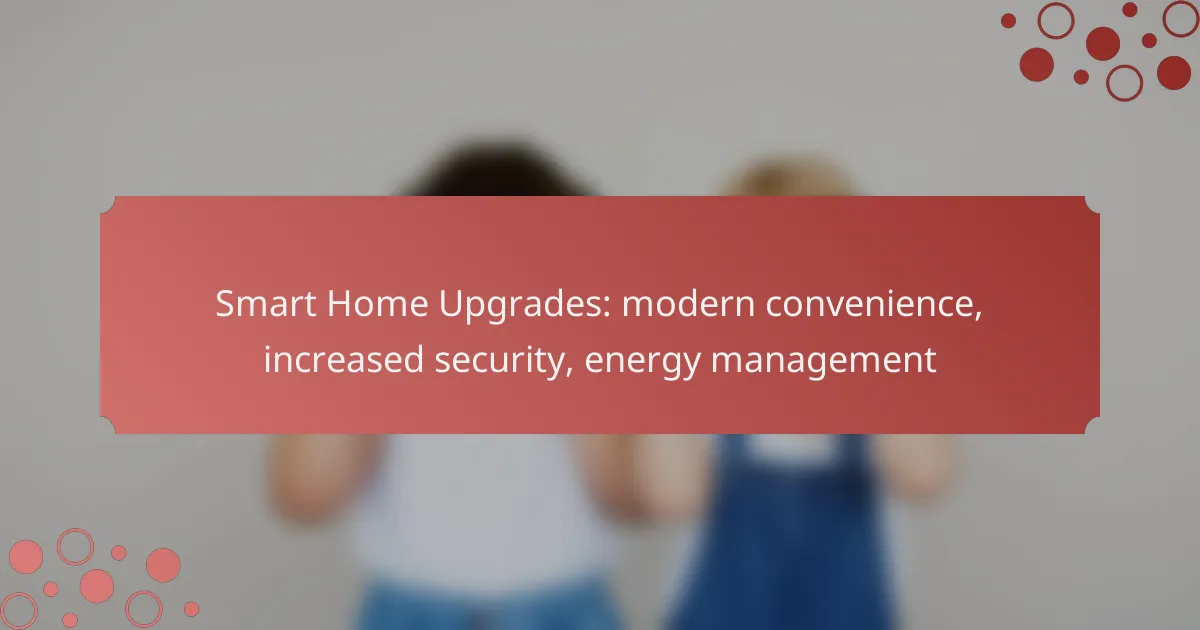Smart home upgrades offer modern convenience, enhanced security, and efficient energy management, transforming the way we live. By integrating advanced technology, these upgrades simplify daily tasks, provide real-time monitoring, and enable homeowners to manage energy consumption effectively. Embracing smart home solutions not only increases comfort but also promotes a more sustainable and secure living environment.
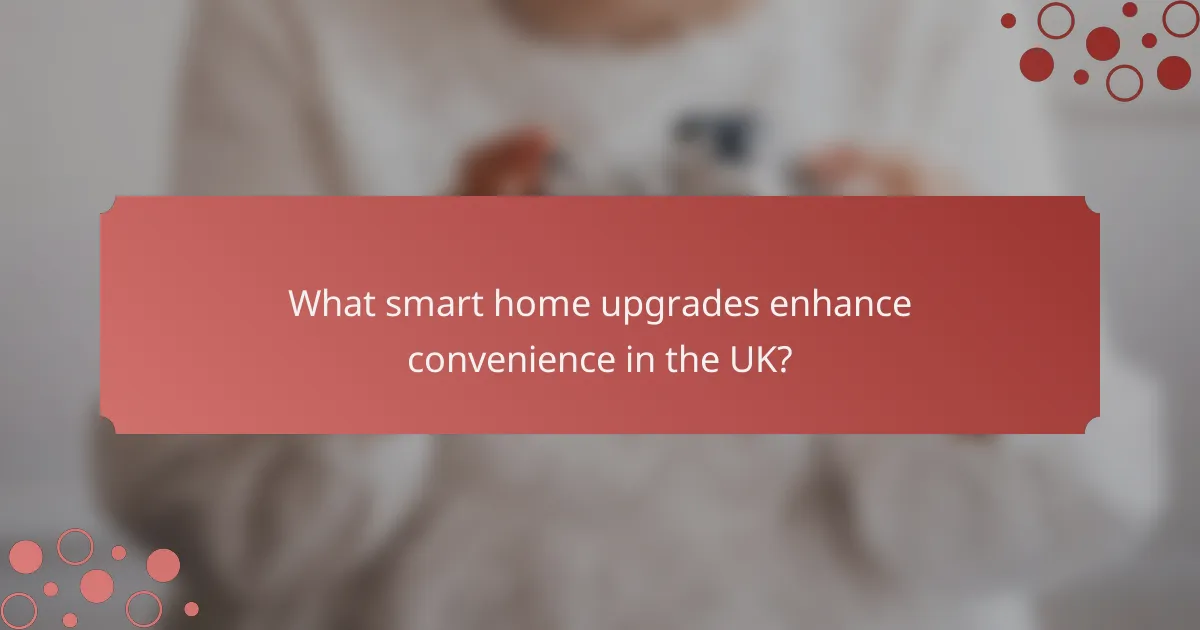
What smart home upgrades enhance convenience in the UK?
Smart home upgrades that enhance convenience in the UK include devices that simplify daily tasks, improve home management, and increase comfort. These upgrades often integrate seamlessly with existing technology, allowing for easy control and automation.
Smart speakers like Amazon Echo
Smart speakers, such as the Amazon Echo, serve as central hubs for controlling various smart home devices. They enable voice commands to manage lighting, play music, set reminders, and even control your thermostat, making daily routines more efficient.
When choosing a smart speaker, consider compatibility with other devices in your home. The Echo works well with a wide range of products, but ensure that your existing devices support integration for optimal performance.
Smart lighting systems such as Philips Hue
Philips Hue smart lighting systems allow users to control the brightness and color of their lights remotely or through voice commands. This flexibility not only enhances convenience but also enables energy savings by scheduling lights to turn off when not needed.
Installation is straightforward, typically involving replacing standard bulbs with smart ones and connecting them to a hub. Users can create scenes or routines, such as dimming lights for movie nights or brightening them for reading, tailored to their preferences.
Smart thermostats like Nest
Smart thermostats, like the Nest, provide automated temperature control based on your habits and preferences. They learn your schedule and adjust heating or cooling accordingly, which can lead to significant energy savings and increased comfort.
When installing a smart thermostat, ensure compatibility with your existing heating system. Many models offer mobile apps for remote management, allowing you to adjust settings from anywhere, which is particularly useful for maintaining comfort while away from home.
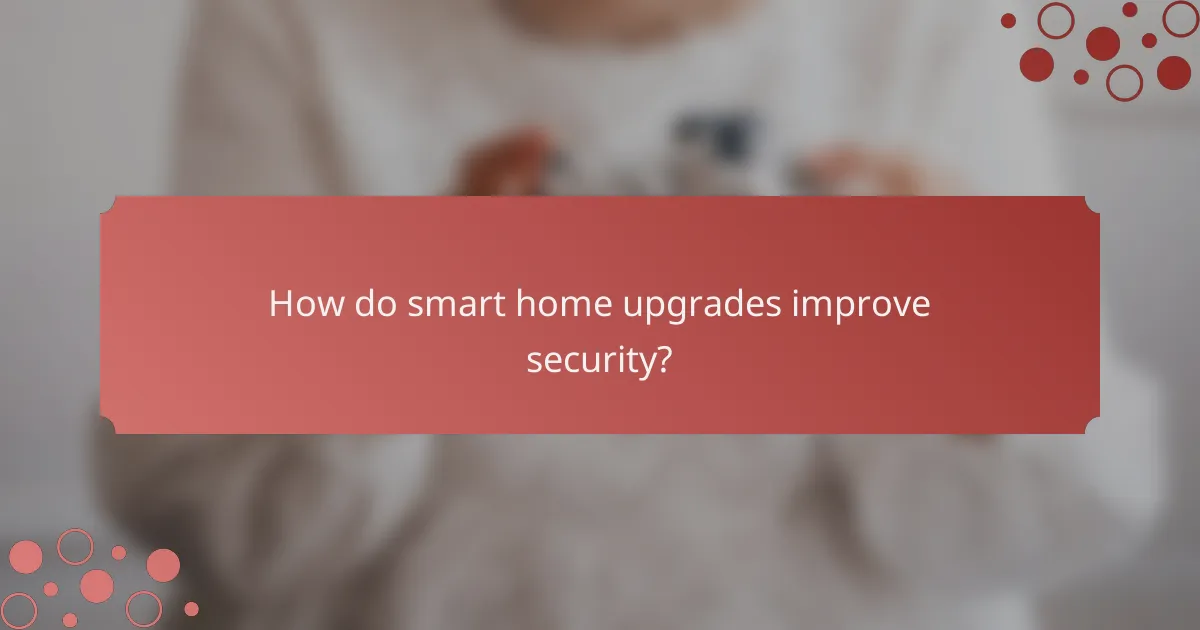
How do smart home upgrades improve security?
Smart home upgrades enhance security by integrating technology that allows for real-time monitoring and control of your home. These systems provide alerts, remote access, and automation features that deter intruders and increase peace of mind.
Smart security cameras from Ring
Smart security cameras from Ring offer high-definition video monitoring and two-way audio, allowing homeowners to see and communicate with visitors remotely. Many models include motion detection and night vision, ensuring comprehensive coverage both day and night.
When selecting a Ring camera, consider features like cloud storage options and integration with other smart home devices. Subscription plans vary, so evaluate which plan suits your needs best, typically ranging from basic to premium services.
Smart locks like August Smart Lock
August Smart Lock enhances home security by allowing keyless entry through smartphones or keypads. This lock can be retrofitted onto existing deadbolts, making installation straightforward without replacing your entire lock system.
With features like temporary access codes for guests and activity logs, homeowners can monitor who enters and exits their home. Ensure compatibility with your door and consider battery life, as some models may require periodic battery replacements.
Home security systems such as ADT
ADT provides comprehensive home security systems that include monitoring services, alarms, and smart home integration. These systems often feature professional installation and 24/7 monitoring, providing an added layer of security.
When choosing an ADT system, evaluate the different packages available, which may include options for video surveillance, environmental monitoring, and smart home devices. Be aware of contract terms and monthly fees, which can vary widely based on the level of service selected.
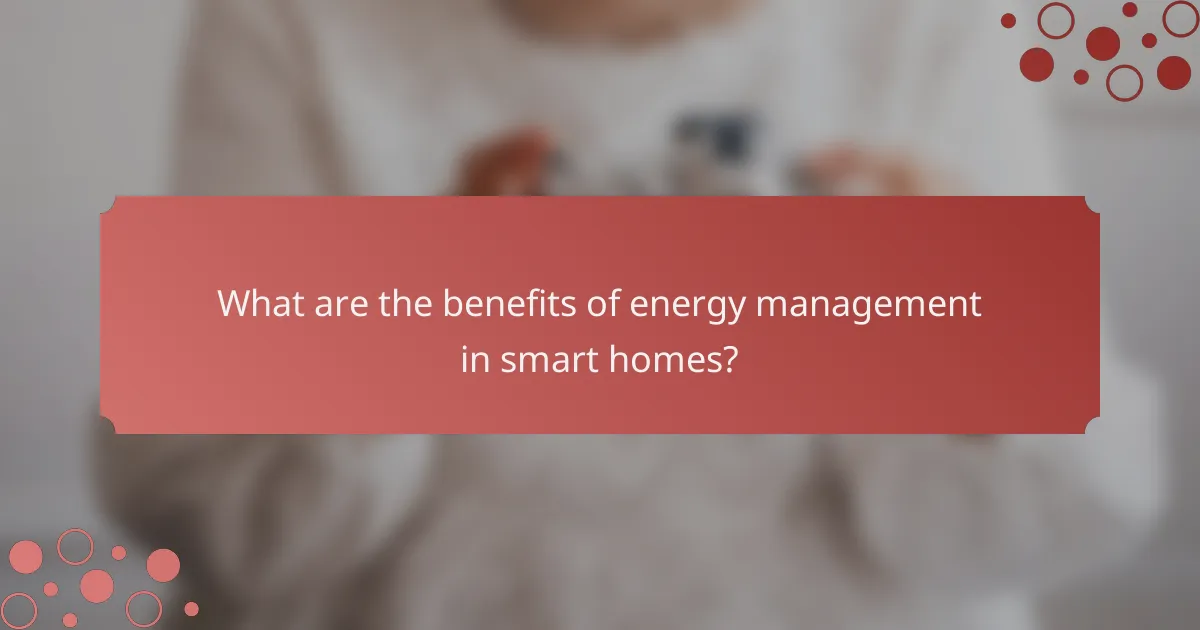
What are the benefits of energy management in smart homes?
Energy management in smart homes enhances efficiency, reduces costs, and minimizes environmental impact. By utilizing smart technology, homeowners can monitor and control their energy usage, leading to significant savings and a more sustainable lifestyle.
Energy-efficient smart plugs
Energy-efficient smart plugs allow users to control devices remotely and schedule their operation. By plugging appliances into these smart devices, homeowners can reduce energy consumption during peak hours or when devices are not in use. This can lead to savings of around 10-15% on energy bills.
When selecting smart plugs, look for features like energy monitoring and compatibility with voice assistants. Avoid overloading plugs, as this can lead to safety hazards and device damage.
Smart thermostats for energy savings
Smart thermostats optimize heating and cooling systems by learning user preferences and adjusting settings accordingly. These devices can save homeowners approximately 10-20% on heating and cooling costs by automatically lowering or raising temperatures when the house is empty.
Consider models that offer geofencing capabilities, which adjust temperatures based on your location. Regularly update the thermostat’s software to ensure optimal performance and security.
Energy monitoring systems like Sense
Energy monitoring systems, such as Sense, provide real-time insights into energy consumption patterns. These systems can identify which devices are using the most energy, helping homeowners make informed decisions about their usage and potential upgrades.
When implementing an energy monitoring system, ensure it is compatible with your home’s electrical setup. Regularly review the data to identify trends and adjust habits accordingly, which can lead to further energy savings.
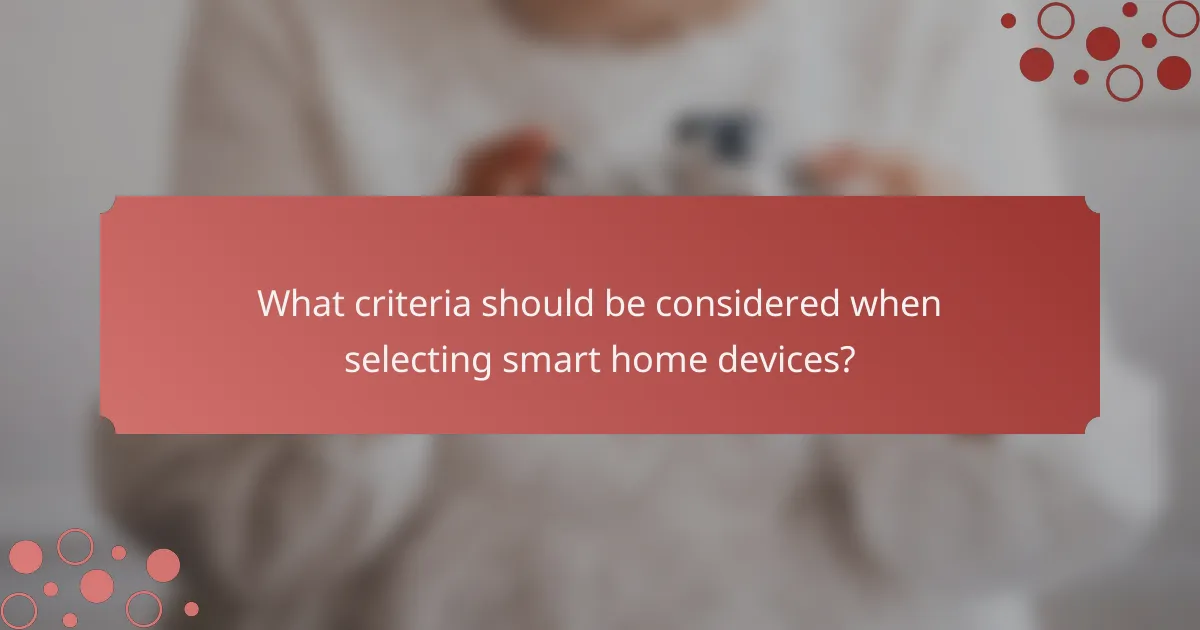
What criteria should be considered when selecting smart home devices?
When selecting smart home devices, it’s essential to consider compatibility with existing systems, user-friendliness, and installation requirements. These factors ensure that devices work seamlessly together and are easy to set up and operate.
Compatibility with existing systems
Compatibility is crucial when choosing smart home devices, as it determines how well new devices will integrate with your current setup. Look for devices that support common standards like Zigbee, Z-Wave, or Wi-Fi, which facilitate communication between devices from different manufacturers.
Before purchasing, check whether your existing smart home hub or ecosystem (like Amazon Alexa, Google Home, or Apple HomeKit) supports the new devices. This can save you from potential frustration and additional costs associated with replacing incompatible devices.
User-friendliness and installation
User-friendliness is a key consideration for smart home devices, especially for those who may not be tech-savvy. Look for devices that offer intuitive interfaces and straightforward setup processes, often guided by mobile apps.
Installation can vary from simple plug-and-play devices to those requiring professional installation. Assess whether you are comfortable with DIY installation or if you might need to hire a technician, which can add to the overall cost. Always read reviews to gauge the experiences of other users regarding ease of use and installation challenges.
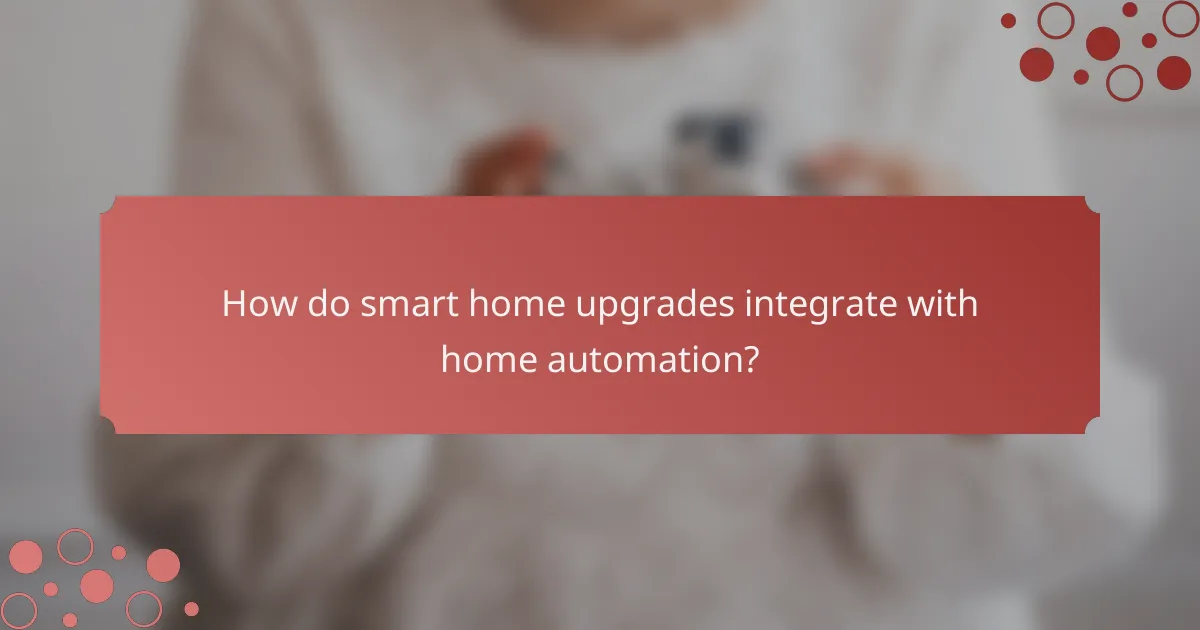
How do smart home upgrades integrate with home automation?
Smart home upgrades seamlessly connect various devices and systems to enhance automation, convenience, and security. By integrating these upgrades, homeowners can control lighting, heating, security, and more from a single platform, creating a cohesive smart home environment.
Integration with platforms like Google Home
Smart home devices often integrate with platforms like Google Home, allowing users to manage their devices through voice commands or a mobile app. This integration supports a wide range of devices, including smart speakers, lights, and thermostats, making it easy to customize settings and routines.
To ensure compatibility, check if your devices are labeled as “Works with Google Assistant.” This can help you avoid purchasing incompatible products and streamline your smart home setup.
Automation routines for daily tasks
Automation routines allow homeowners to set up schedules or triggers for their smart devices, simplifying daily tasks. For example, you can program your lights to turn on at sunset or set your thermostat to adjust temperatures based on your daily schedule.
Consider creating routines that align with your lifestyle, such as a “Good Morning” routine that gradually brightens lights and starts your coffee maker. This not only enhances convenience but can also lead to energy savings by optimizing device usage throughout the day.
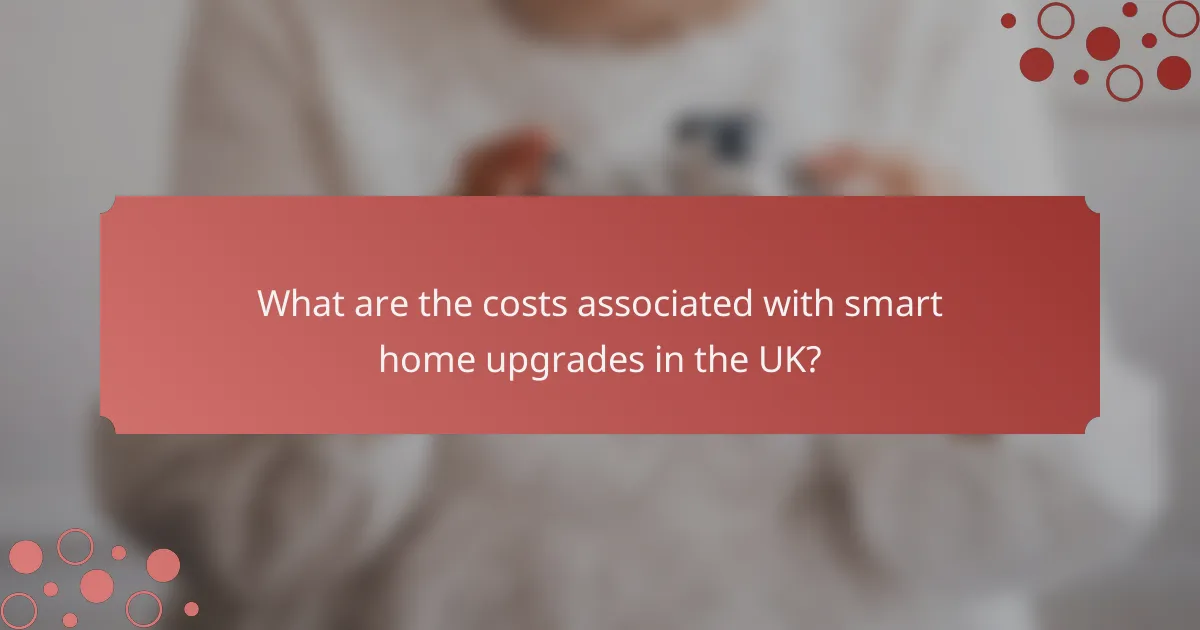
What are the costs associated with smart home upgrades in the UK?
The costs of smart home upgrades in the UK can vary significantly based on the devices and systems you choose. Initial investments can range from a few hundred to several thousand pounds, while long-term savings on energy bills can help offset these costs over time.
Initial investment for devices
When considering smart home upgrades, the initial investment for devices is a crucial factor. Basic smart devices like smart bulbs or plugs can start at around £10 to £30 each, while more advanced systems, such as smart thermostats or security cameras, may range from £100 to £300. Comprehensive smart home systems that integrate multiple devices can cost upwards of £1,000.
It’s essential to assess your needs and budget before purchasing. Prioritize devices that offer the most value, such as smart thermostats that can lead to significant energy savings, or security systems that enhance your home’s safety.
Long-term savings on energy bills
Smart home upgrades can lead to substantial long-term savings on energy bills. For instance, smart thermostats can reduce heating costs by approximately 10-20% by optimizing temperature settings based on your habits. Similarly, smart lighting systems can lower electricity usage by allowing you to control lights remotely and set schedules.
To maximize savings, consider investing in energy-efficient devices and using energy monitoring systems to track usage. Regularly reviewing your energy consumption can help identify further opportunities for savings, ensuring that your smart home upgrades pay off in the long run.
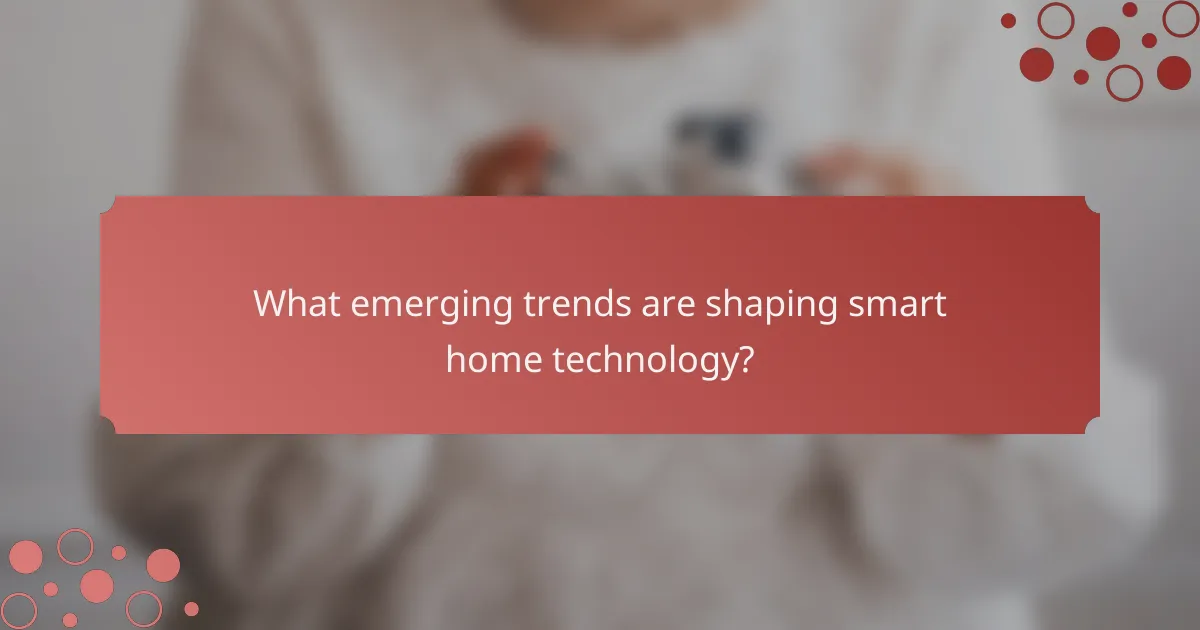
What emerging trends are shaping smart home technology?
Emerging trends in smart home technology focus on enhancing convenience, security, and energy management. Innovations such as AI-driven automation and increased attention to privacy are transforming how homeowners interact with their living spaces.
AI-driven home automation
AI-driven home automation utilizes machine learning algorithms to optimize household tasks and improve user experience. These systems can learn from user behavior, adjusting settings for lighting, heating, and security based on preferences and patterns.
For example, smart thermostats can analyze your daily routines to adjust temperatures automatically, potentially saving energy costs by 10-20%. Consider integrating devices that communicate with each other to create a seamless smart home ecosystem.
When implementing AI-driven solutions, ensure compatibility among devices and prioritize those that offer user-friendly interfaces. Avoid overcomplicating your setup with too many devices that may not work well together.
Increased focus on privacy and security
As smart home technology expands, there is a growing emphasis on privacy and security measures. Homeowners are increasingly concerned about data breaches and unauthorized access to their devices, leading to the development of more robust security protocols.
To enhance security, consider devices that offer end-to-end encryption and regular software updates. Use strong, unique passwords for each device and enable two-factor authentication where available. Regularly review privacy settings to ensure your data is protected.
Be cautious of devices that require excessive personal information or lack transparency in data usage. Research brands that prioritize user privacy and comply with relevant regulations, such as GDPR in Europe or CCPA in California, to safeguard your smart home environment.
